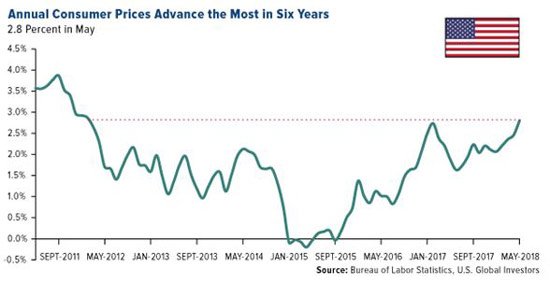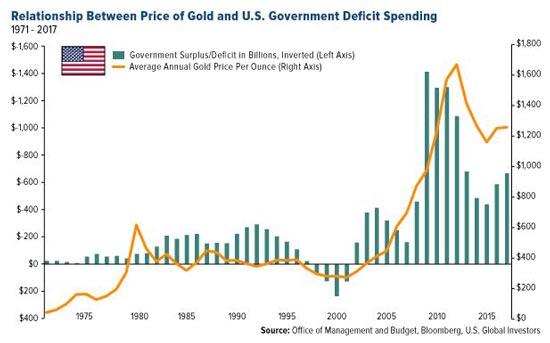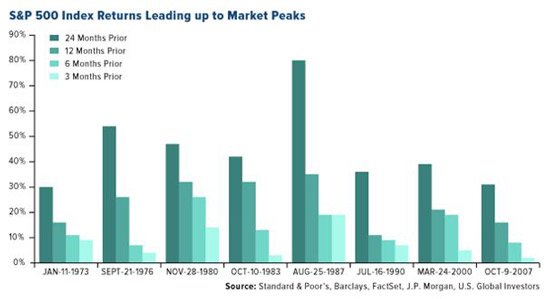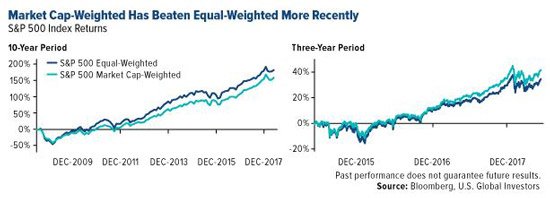Editor’s Note: Today we want to share with you this subscribers-only content from U.S. Global Investors CEO Frank Holmes. It’s part of his weekly Investor Alert, which you can get delivered straight to you. Just use the link at the end of this article to sign up. Now, here’s Frank…
The U.S. inflation story made further inroads this month, with year-over-year price growth for consumers and producers alike hitting multiyear highs.
U.S. consumer prices expanded at their strongest pace in more than six years, climbing to an annual change of 2.8 % in May. Prices for final demand goods, meanwhile, grew 3.1%, their strongest annual surge since December 2011.

As you might expect, energy was the greatest contributor to higher prices in May, with fuel oil jumping more than 25% from the same month a year ago. The current average price for a gallon of regular gas nationwide was just under $3.00, compared to only $2.33 in June 2017, according to the American Automobile Association (AAA).
Inflation is set to get an even bigger jolt now that U.S. President Donald Trump has formally approved 25% tariffs on as much as $50 billion of Chinese goods. China has already announced retaliatory action.
While I agree that some targeted tariffs are welcome to address intellectual property theft, tariffs at the wholesale level are essentially regulations that threaten to undermine all the work Trump has done to supercharge the U.S. economy. They act as headwinds to further growth, which in turn makes gold look attractive as a safe-haven investment.
Let’s take a look at some other factors playing into this…
Blaming OPEC
We’ll return to energy for a moment.
Hot off the success of his historic summit with North Korean leader Kim Jong Un, Trump took a stab at foreign oil producers last week, tweeting: “Oil prices are too high, OPEC is at it again. Not good!”
You Must Act Now: America is headed for an economic disaster bigger than anything since the Great Depression. If you lost out when the markets crashed in 2008, then you are going to want to see this special presentation…
The president isn’t wrong, but I believe he may be overselling the Organization of Petroleum Exporting Countries’ (OPEC’s) influence here.
In May, the 14-member cartel added an extra 35,000 barrels per day (bpd) in output compared to the previous month, to reach a total of 31.8 million bpd. This is down from the average 32.6 million and 32.4 million bpd OPEC collectively produced in 2016 and 2017.
Venezuela’s output deteriorated once again, falling more than 42% in May, to 1.4 million bpd, which is less than half of what it produced 20 years ago.
The beleaguered South American country didn’t have the biggest monthly decline among OPEC members, however – that title belonged to Nigeria, which saw its April-to-May production tumble 53.5% to 1.7 million bpd. Analysts predict output could fall further, to 1.4 million bpd, by July – a level not seen since 1988 – as the country’s Nembe Creek Trunk Line has had to be closed recently to address product theft along its route.
OPEC will meet later this month and is widely expected to loosen production curbs as global demand strengthens.
In the meantime, the United States continues to pump even more oil on a monthly basis, and by 2019, it could be producing more than 11 million bpd for the first time ever. This would make it the world’s top oil producer, above Russia.
Gold Glitters on Inflation Fears and U.S. Budget Imbalance
The inflation news helped support the price of gold, which traded as high as $1,309 an ounce last Thursday, its best intraday showing in four weeks.
The price jump came a day after the U.S. Federal Reserve lifted interest rates another 0.25%, the second time it has done so this year.
Although rising rates have historically made the precious metal look less competitive, since it doesn’t offer a yield, gold markets could be forecasting slower economic growth as a result of higher borrowing costs, not to mention costlier servicing of corporate and government debt.
On that note, the Treasury Department announced last week that in the first eight months of the current fiscal year – October through May – the U.S. government deficit widened to a whopping $532 billion, or 23% more than the same eight-month period a year ago. That’s already more than the total deficits in fiscal years 2014 and 2015.
Due to higher spending and lower revenue, it’s estimated that the deficit by the end of the fiscal year will balloon to $833 billion, which would be the greatest amount since 2012.
No Place for Fear, Panic, or Mistakes: You may only have a few months to prepare. A market signal that showed up before the Great Depression… before the dot-com crash… and before the 2008 financial crisis has just appeared again, and investors only have a few short months before chaos strikes. You must act now. Click here to discover how.
I believe this makes the investment case for gold and gold equities even more appealing as a store of value. In the chart below, notice how the price of gold has responded to government spending. I inverted the bars, representing surplus and deficit, to make the relationship more clear.

In the years following the Clinton surplus of the late 90s, the difference between expenditure and revenue surged to new record amounts on the back of military spending in the Middle East and the multibillion-dollar bailouts of financial firms during the subprime mortgage crisis. Consequentially, the price of gold exploded.
How Close Are We to the End of the Business Cycle?
Let’s get back to the Fed.
Besides lifting rates, the central bank has also signaled that we can expect two more hikes in 2018, suggesting it sees less and less need to accommodate a booming U.S. economy. Since the start of this particular rate hike cycle two and a half years ago, we haven’t yet seen four increases in a single calendar year.
This raises the question of how close we are to the end of the business cycle.
Rising rates, among other indicators, have often preceded the end of economic expansions and equity bull markets. Among other telltale signs: a flattening yield curve, record corporate and household debt, an overheated jobs market, and increased mergers and acquisition (M&A) activity.
So far this year, the value of global M&As has already reached $2 trillion, a new all-time high. The last two periods when M&As reached similar levels were in 2007 ($1.8 trillion) and in 2000 ($1.5 trillion), according to Reuters. Careful readers will note that those two years came immediately before the financial crisis and tech bubble.
Now, the world’s largest hedge fund, Bridgewater Associates, has reportedly turned bearish on “almost all financial assets,” according to one of its most recent notes to investors.
In the firm’s “Daily Observations,” co-CIO Greg Jensen writes that “2019 is setting up to be a dangerous year, as the fiscal stimulus rolls off while the impact of the Fed’s tightening will be peaking.”
Don’t Miss the Opportunities
Be that as it may, calling the end of the cycle would be a fool’s errand and could result in missed opportunities, as JPMorgan Chase & Co.‘s (NYSE: JPM) Samantha Azzarello points out in a recent note to investors. Late-cycle returns can still be quite substantial, she says.
Take a look at the chart below, which highlights returns 24 months, 12 months, six months, and three months leading up to the past eight market peaks.

Obviously, returns were higher in the longer-term periods, but even the three-month periods delivered some attractive returns – returns that would be left on the table if skittish investors exited now. According to Azzarello, it’s important to “rebalance, stick to a plan and remember: get invested and stay invested.”
As further proof that many investors still see plenty of fuel in the tank, the June survey of fund managers conducted by Bank of America Merrill Lynch found that equity investors are overweight on U.S. stocks for the first time in 15 months.
Commodity allocations are at their highest in eight years. And two-thirds of managers say the United States is the best region in the world right now for corporate profits, which are at a 17-year high.
That’s not to say there aren’t risks. 42% of survey participants said they believed corporations were overleveraged. That’s well above the peak of 32% from soon before the start of the financial crisis. Fund managers cited “trade war” as the biggest “tail risk” for markets at present.
This is largely why we find domestic-focused small- to mid-cap stocks so attractive right now. These firms are well-positioned to take advantage of Trump’s high-growth “America first” policies, yet because they don’t have as much exposure to foreign markets, they bypass many of the trade war pitfalls large multinationals must face.
Since Election Day 2016, the small-cap Russell 2000 Index has outperformed the large-cap S&P 500 Index by more than 8.5%.
Rethinking Market-Cap-Weighting
On a final note, I want to draw attention to a change we’ve observed in S&P 500 returns-specifically, the difference in performance between an equal-weighted basket of stocks and one that’s market-cap-weighted.
For the longer-term period, equal-weighting outperformed. But more recently, market-cap-weighting has pulled ahead. This is the case for the one-year, three-year, and five-year periods.

So why is this? Simply put, the phenomenally large FAANG stocks – Facebook Inc. (Nasdaq: FB), Apple Inc. (Nasdaq: AAPL), Amazon.com Inc. (Nasdaq: AMZN), Netflix Inc. (Nasdaq: NFLX), and Google Inc. (Nasdaq: GOOGL) – have made the S&P 500 top-heavy. Today, these five stocks represent a highly concentrated 12% of the S&P 500, nearly double from their share just five years ago. Apple alone represents 4% of the large-cap index.
Ten years ago, the FAANG stocks – excluding Facebook, which wasn’t public yet – had a combined market cap of $390 billion, according to FactSet data. In 2018, they’re valued at more than eight and a half times that, or right around $3.32 trillion – a mind-boggling sum.
Market-cap-weighted also means more money is disproportionately being reallocated to top winners such as Apple and Amazon, and so it becomes a self-fulling prophecy.
This leaves you with too much exposure to companies that would be hardest hit in the event of a market downturn, and too little exposure to names and sectors that might rotate to the top in the next cycle.
[Editor’s Note: Frank Holmes is chief executive officer and chief investment officer of U.S. Global Investors Inc., which manages a diversified family of mutual funds and hedge funds specializing in natural resources, emerging markets, and infrastructure. He has been profiled by Fortune, Barron’s, Financial Times, and other publications. If you want commentary and analysis from Holmes and the rest of the U.S. Global Investors team delivered to your inbox every Friday, sign up to receive the weekly Investor Alert at www.usfunds.com.
Here’s more about U.S. Global Investors Inc.:
All opinions expressed and data provided are subject to change without notice. Some of these opinions may not be appropriate to every investor. By clicking the link(s) above, you will be directed to a third-party website(s). U.S. Global Investors does not endorse all information supplied by this/these website(s) and is not responsible for its/their content.
Holdings may change daily. Holdings are reported as of the most recent quarter-end. None of the securities mentioned in the article was held by any accounts managed by U.S. Global Investors as of 6/30/2016.
U.S. Global Investors, Inc. is an investment adviser registered with the Securities and Exchange Commission (“SEC”). This does not mean that we are sponsored, recommended, or approved by the SEC, or that our abilities or qualifications in any respect have been passed upon by the SEC or any officer of the SEC.
This commentary should not be considered a solicitation or offering of any investment product.
Certain materials in this commentary may contain dated information. The information provided was current at the time of publication.]
Your Financial Future Is at Stake (Are You Prepared?)
If you’re like most Americans, you’ve felt a sense of market turmoil ahead. We could be in for another white-knuckle ride… a “Great Reckoning,” if you will.
The vast majority of folks don’t see this coming, and those few who do are not preparing properly… nor profitably.
So ask yourself, right now: Are you where you want to be financially?
If the answer is yes, that’s great.
If the answer is no, then understand that you are not alone – and you need to click here now…
Follow Money Morning on Twitter, Facebook, and LinkedIn.
About Money Morning: Money Morning gives you access to a team of ten market experts with more than 250 years of combined investing experience – for free. Our experts – who have appeared on FOXBusiness, CNBC, NPR, and BloombergTV – deliver daily investing tips and stock picks, provide analysis with actions to take, and answer your biggest market questions. Our goal is to help our millions of e-newsletter subscribers and Moneymorning.com visitors become smarter, more confident investors.To get full access to all Money Morning content, click here.
Disclaimer: © 2018 Money Morning and Money Map Press. All Rights Reserved. Protected by copyright of the United States and international treaties. Any reproduction, copying, or redistribution (electronic or otherwise, including the world wide web), of content from this webpage, in whole or in part, is strictly prohibited without the express written permission of Money Morning. 16 W. Madison St. Baltimore, MD, 21201.

